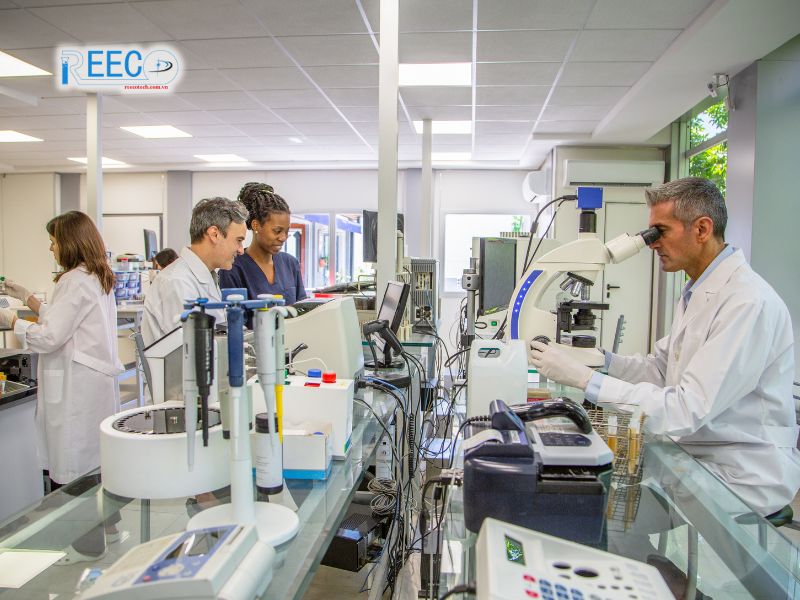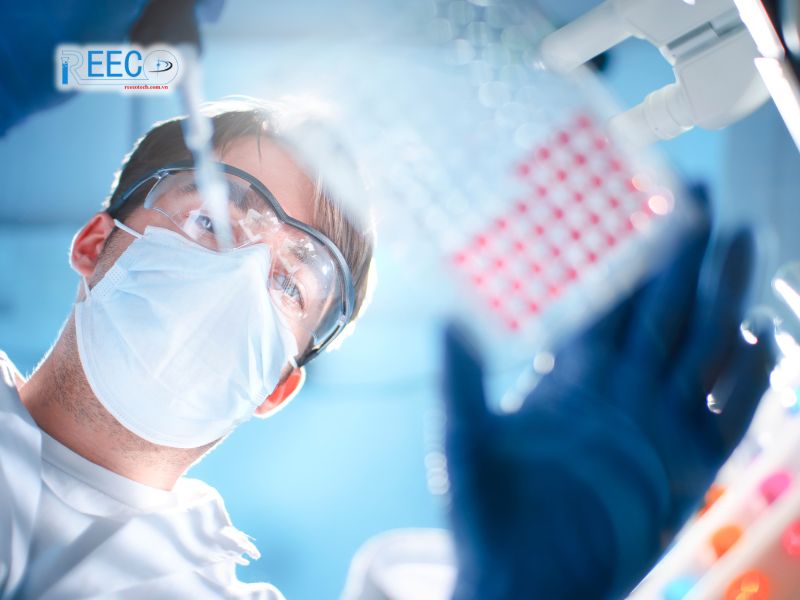In the realm of science and technology, laboratories (or labs) play a pivotal role. These are the spaces where researchers, engineers, and experts conduct experiments, analyses, and tests to gather data, develop products, and improve processes. So, what exactly is a laboratory, and how are they categorized, standardized, and equipped? Join Reecotech as we delve into this topic in the article below.
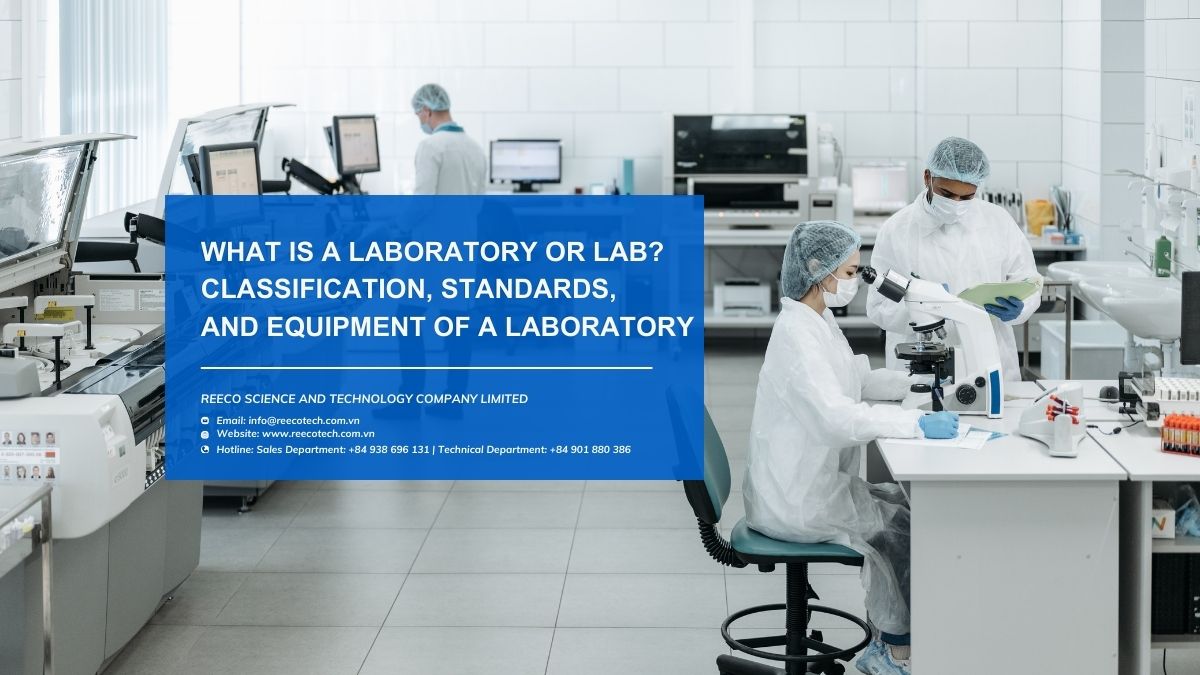
What is a Lab? What is a Laboratory?
A laboratory, often abbreviated as a lab, is a specially designed space where research, experiments, and analysis are conducted. It’s where scientists, engineers, and other professionals perform tests, inspections, and measurements to explore and understand the natural world, as well as develop new products and technologies.
Labs are not only equipped for experiments in natural sciences like biology, physics, and chemistry but also serve as creative spaces for students, especially in STEAM education. This early exposure to technology fosters creativity and innovation, aligning with the trends of 4.
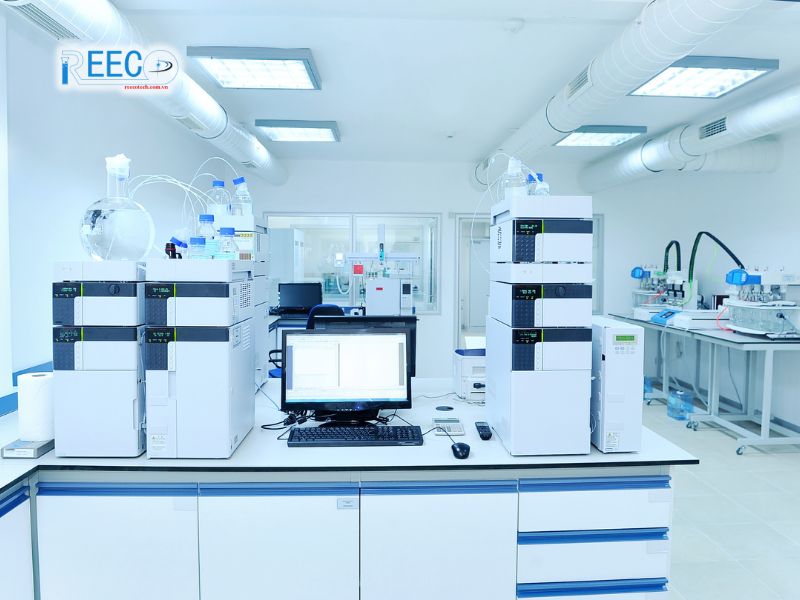
Labs can be found in educational institutions at all levels, from universities and high schools to kindergartens, elementary, and middle schools. Depending on their purpose, labs are designed with varying sizes and equipment. For instance, a physics lab might contain particle accelerators or vacuum chambers, while a STEM lab could be equipped with 3D printers or laser cutters, enabling students to create projects like smart homes, smart trash cans, or autonomous robots.
Some of the most common types of laboratories today
- Chemistry and physics laboratories
- Medical laboratories
- Public health laboratories
- Research laboratories for drugs or special technologies
- Media laboratories
- Research and learning laboratories
- Darkroom or projection laboratories
- Computer laboratories
- Secret laboratories for producing illegal drugs or technologies
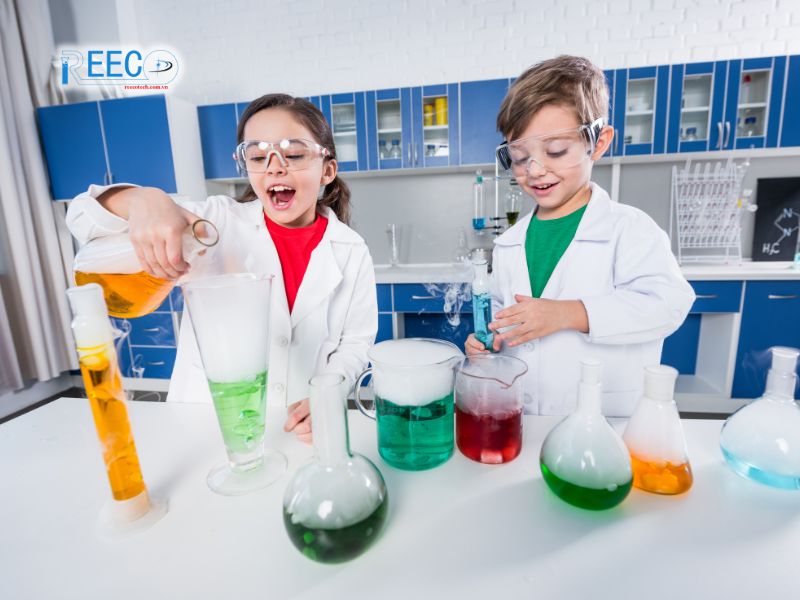
Currently, there are two prevalent types of laboratory facilities in educational institutions:
Specialized laboratories: These are equipped with specific hardware devices that are selected and designed based on detailed research for each function. Such laboratories are suitable for schools with limited budgets, providing both economic efficiency and meeting teaching needs.
Multipurpose laboratories: These have the capability to serve multiple subjects. These laboratories are designed with numerous computers of higher configurations and advanced technological equipment. Moreover, they must meet stringent hardware and software requirements to ensure optimal operational efficiency.
What is the purpose of a laboratory?
A laboratory can be a designated room within a building or a standalone structure, specially designed to facilitate experiments conducted by students, researchers, and scientists.
Individuals studying fields such as biomedical science, food technology, biotechnology, pharmacy, biomedical engineering, and chemistry, among others, will undoubtedly require laboratory access to perform their experiments.
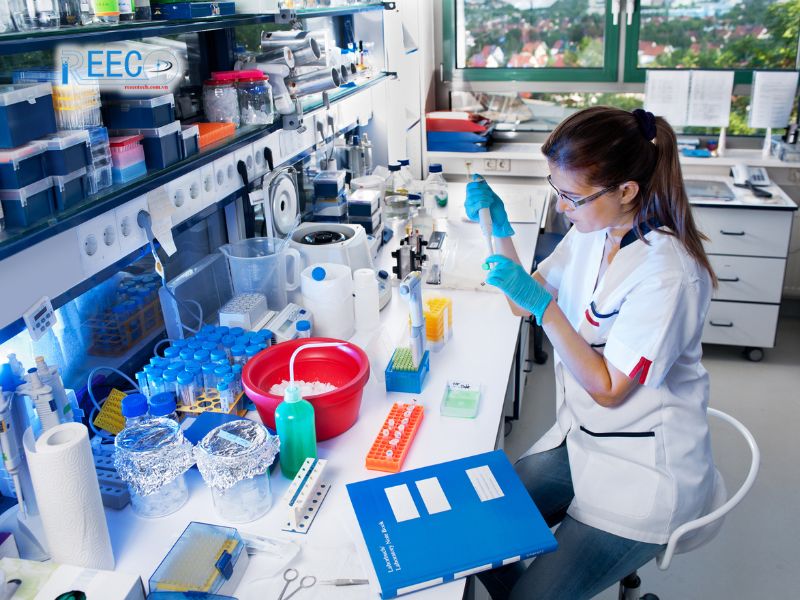
Standards for Designing a Standard Laboratory
Requirements for Lighting
Lighting is an essential factor in any working environment, especially in places that require a high degree of accuracy. In these environments, light control needs to be more strictly enforced.
According to laboratory design standards, a room can be illuminated by natural or artificial light. Good lighting will support employees in performing tasks in detail, safely and efficiently, thereby reducing unnecessary waste. At the same time, the lighting system design needs to ensure that it does not cause glare or be too dim.
Temperature Requirements
Each laboratory in different industries will have its own specific temperature requirements. Therefore, the temperature needs to be designed to suit the function and purpose of each room. To ensure that the design meets the standard and is not affected by external factors, heat-generating equipment should be placed far away or separated from the workspace.
Ventilation System Requirements
The ventilation system is an essential element in clean rooms and laboratories. This system needs to be installed in accordance with the requirements of each laboratory and must comply with laboratory design standards to ensure an optimal working environment.
Laboratories often use many chemicals, which can produce unpleasant odors, smoke, or toxins. Therefore, it is necessary to establish a local ventilation system in the work areas. Airflow velocity is also an important factor that needs to be monitored regularly to ensure that toxic gases and potential pollutants do not spread to the surrounding environment.
Noise Requirements
When designing laboratories, the selection of machinery and equipment needs to be carefully carried out, including the calculation of noise levels. Measures to reduce or eliminate noise need to be implemented to avoid excessively high noise levels, ensuring that it does not affect work efficiency in the laboratory.
Ergonomic Factors
Machinery and equipment in the laboratory need to be designed and arranged to suit the purpose of the work as well as the operations performed. In particular, it is necessary to limit risks and errors that can affect the safety of workers and product quality.
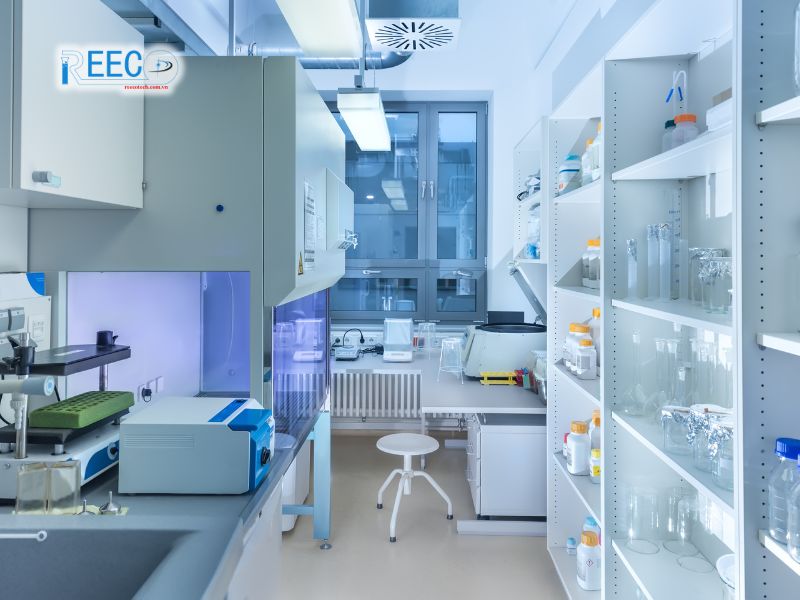
Layout for working with potentially airborne pathogens
Laboratory design standards must be applied to all laboratories involving biological agents. For microorganisms that are potentially airborne and pose a risk to personal safety and the environment, they must be designed in appropriate locations. In particular, stricter preventive measures are required for microorganisms in risk group III and above.
Laboratory doors
According to laboratory design standards, laboratory entrances and exits must be clearly marked and labeled. In particular, for laboratories containing hazardous biological agents, flammable or explosive substances, or radiation, there must be warning signs indicating the level of danger according to international regulations and the unit’s regulations.
Laboratory safety
As required by laboratory design, all laboratory doors must be lockable and easy to open and close to ensure quick evacuation in emergencies. An internal lock should be provided to restrict entry and contact when conducting experiments with highly hazardous samples. Only authorized personnel who are familiar with the regulations are allowed to enter the laboratory. At the same time, it is necessary to always be prepared for risks related to data theft, equipment theft, or the falsification of biological agents, samples, and chemicals.
Laboratory rules must be strictly adhered to
Before entering the lab, students must ensure that they have a thorough understanding of the general regulations to guarantee safety, as safety is always the top priority.
- Students are only permitted to conduct experiments under the supervision of a teacher within the lab.
- It is essential to carefully read the instructions and think critically before starting any experiment.
- The location of all safety equipment in the lab must always be known.
- Adherence to the protective clothing regulations is mandatory, including wearing a lab coat, safety goggles, and tying hair back neatly.
- Lab benches must be cleaned before starting any experiment.
- Under no circumstances should lab chemicals be tasted, and eating or drinking is strictly prohibited in the lab.
- Directly looking into test tubes containing chemicals is forbidden.
- In case of any accidents, such as spilling chemicals, the teacher or lab manager must be informed immediately.
- After completing the work, hands and face must be washed, and experimental equipment must be cleaned according to the regulations.
- Any skin contact with chemicals should be rinsed immediately, and if chemicals get into the eyes, they should be flushed with water immediately.
- Laboratory waste must be disposed of in the designated area according to the instructions.
- If anything is unclear, do not hesitate to ask for clarification.
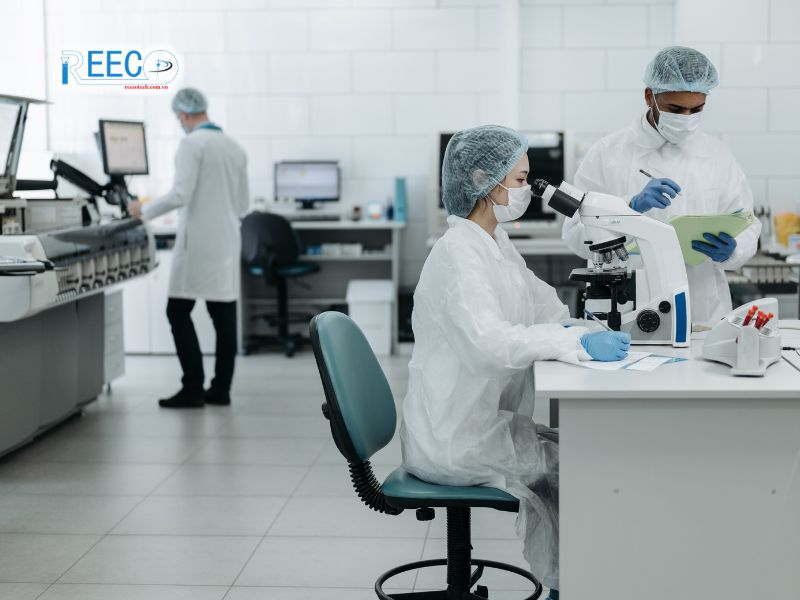
Typical Laboratory Equipment
To conduct experiments effectively, using the right laboratory equipment is of paramount importance. Here are some essential equipment found in laboratories:
a. Laboratory bench, table, and shelving system
The laboratory bench is the most basic equipment, providing the necessary space and surface for experiments. The design of a laboratory bench must adhere to standards such as chemical resistance, non-flammability, fire resistance, water resistance, and a high load-bearing capacity. Additionally, it should be antimicrobial and prevent the growth of microorganisms.
b. Laboratory water purification system
Impurities in water can significantly impact the efficiency and quality of experiments. A water purification system is a crucial piece of equipment that ensures experiments run smoothly. It provides pure water with consistent quality.
c. Laboratory autoclave
An autoclave uses saturated steam to sterilize laboratory equipment and instruments, eliminating bacteria, viruses, fungi, and spores. This equipment is commonly found in healthcare facilities, laboratories, and many other places to ensure the sterility of reusable instruments and chemicals.
=> For reference, please see the laboratory equipment analysis section on Reecotech’s website
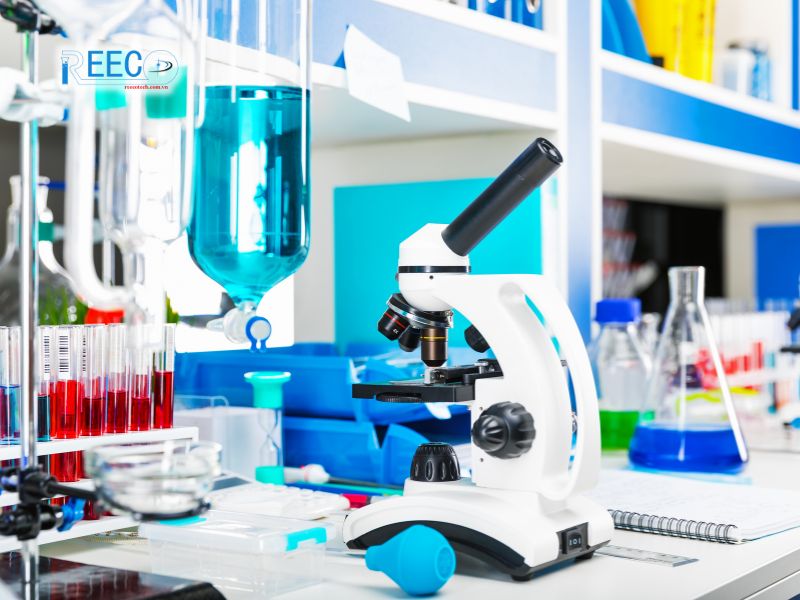
d. Biological Safety Cabinet
A biological safety cabinet protects the operator from the risk of virus infection during manipulation, while ensuring a clean and sterile working environment.
e. Magnetic Stirrer for Laboratory
A magnetic stirrer uses a magnetic field to heat and dissolve chemical components in liquids. It is an indispensable piece of equipment in any laboratory.
Work of lab staff
Laboratory personnel undertake a wide range of responsibilities including research, analysis, and data management for various experiments or products. Specific duties include:
Quality assurance testing of samples: Assessing the quality of raw materials, semi-finished products, or finished goods against Vietnamese standards. Parameters such as pH, salinity, bulk density, moisture content, and EC are commonly measured. These results support product research and meet the company’s production needs.
Determination of specific parameters: Identifying properties like specific gravity and porosity of products or substances based on Vietnamese standards.
Client sample analysis: Conducting analyses and tests on samples submitted by customers.
New product evaluation: Assessing the quality of new products based on customer samples.
Chemical preparation calculations: Calculating the necessary parameters and quantities for chemical preparation according to specified requirements.
Equipment calibration: Inspecting and calibrating measuring instruments in accordance with guidelines and job requirements.
Quality management system adherence: Following quality management procedures and fulfilling the requirements of the ISO 9001 quality management system.
Laboratory maintenance: Ensuring the laboratory is clean, organized, and compliant with laboratory safety regulations.
Data management: Regularly updating data in the management system as required, ensuring easy accessibility and traceability of data and information.
Laboratory Technician: A Role Requiring High Expertise and Rigo
A laboratory technician position demands a high level of expertise and meticulous attention to detail. This job description outlines the specific responsibilities and qualifications necessary for this role. It also provides hiring managers with a detailed framework to tailor job postings accurately and attract the most suitable candidates.
To succeed as a Laboratory Technician, you need to meet the following qualifications and skills:
- A Bachelor’s degree or higher in Biology, Chemistry, Pharmacy, or a related field.
- Practical experience working in a laboratory or participating in research projects at a university.
- Experience operating both electrical and non-electrical laboratory equipment.
- Ability to confidently and proficiently handle potentially hazardous substances (flammable liquids, toxic substances, etc.).
- In-depth knowledge of laboratory safety management systems, preventive measures, and best practices.
- Proficiency in MS Office Suite and database systems.
- Ability to work independently and under pressure.
- Dexterity and quick thinking.
- Excellent verbal and written communication skills.
- Attention to detail and strong analytical skills.
- Critical thinking and effective problem-solving skills.

